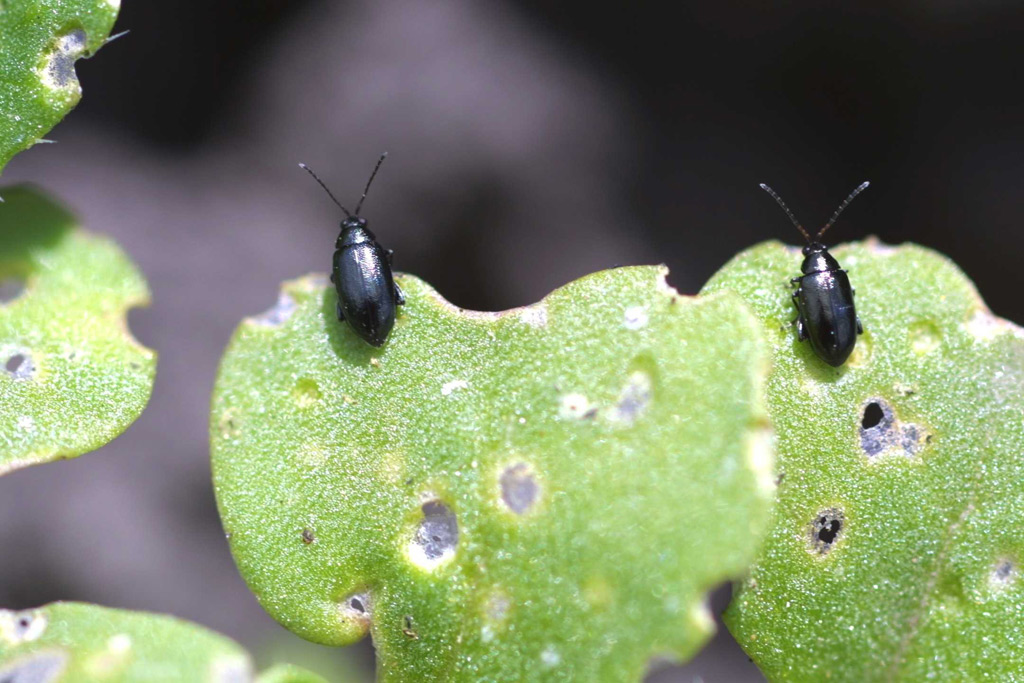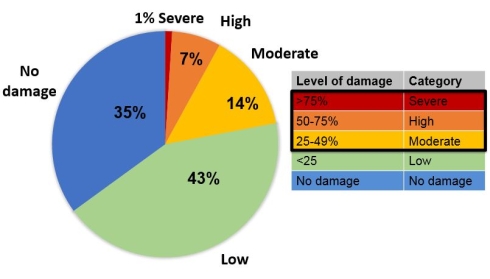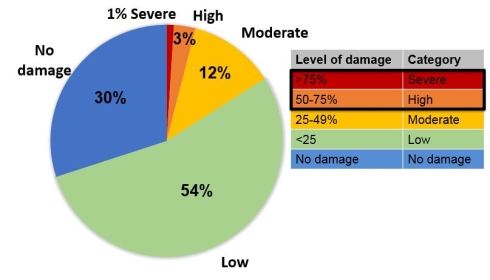
Winter oilseed rape (WOSR) crop losses associated with adult cabbage stem flea beetle activity in autumn 2015 have been estimated at around 1% (6,000ha).
The losses are less than those estimated during autumn 2014, which suggested that 2.7% of the crop area was lost at that time.
However, as different methodology was used, care has to be taken when making direct comparisons.
As in 2014, crop loss and damage estimates were calculated by ADAS using information supplied by AICC agronomists.

Assessments were made only on WOSR crops drilled without neonicotinoid seed treatment.
Caroline Nicholls, AHDB Research Manager, said: “Autumn 2015 marked the second season where neonicotinoid seed treatments were not available for the vast majority of oilseed rape crops.
“Once again, we asked a 56-strong network of agronomists to report on crop damage and loss across 42 counties in England, Wales and Scotland.

“Unlike 2014, where crops were assessed over a seven-day ‘snapshot’ period, the autumn 2015 assessment was linked to crop growth stages.”
Caroline Nicholls presented the findings at the 2015 Agronomists' Conference
What was assessed?
Assessments were made by agronomists at two periods based on the current adult CSFB spray thresholds:
Assessment 1 – Once 75% of crops had reached the cotyledon–two true leaf growth stage
Assessment 2 – Once 75% of crops had reached the three-four leaf growth stage
At each assessment period, agronomists were asked to estimate the proportion of the WOSR crop area in each of the following damage categories:
1. No damage: No leaf area lost to CSFB
2. Low: >0–24% leaf area lost to CSFB
3. Moderate: 25–49 leaf area lost to CSFB
4. High: 50–75% leaf area lost to CSFB
5. Severe: >75% leaf area lost to CSFB
Agronomists were also asked to estimate the proportion of crops that had been completely lost (abandoned), declaring losses due to both CSFB and other causes.
What was observed?
A total of 62,000ha was assessed in this survey, which equates to about 11% of the total UK WOSR area.
At Assessment 1, 0.8% of the assessed area was lost due to CSFB, which equates to 5,000ha of WOSR at the national scale. It was also estimated that 78% of the WOSR crop area was under the threshold for treatment.
At Assessment 2, 1% of the assessed area was lost due to CSFB, which equates to 6,000ha of WOSR at the national scale. It was also estimated that 96% of the WOSR crop area was under the threshold for treatment.
These pie charts were presented at the 2015 Agronomists’ Conference. They show the estimated proportion of the winter oilseed rape crop area in each of the damage categories at Assessment 1 (top) and Assessment 2 (bottom). The thick black borders highlight the damage categories where a spray to target adult cabbage stem flea beetles should be considered (the thresholds). Unlike Assessment 2, the Assessment 1 spray threshold includes crops judged to have a moderate level of damage.
In autumn 2014, it was estimated that 2.7% of the crop area was lost. The autumn 2015 observations suggest that loss levels are lower for the current crop.
As in 2014, there was considerable variation in crop loss to CSFB across the UK. Some counties were reported as being unaffected, whereas others were reported as having relatively high levels of loss.
The county with the highest reported level of crop loss was Buckinghamshire. In this county, it was estimated that 9% of its WOSR area had been lost to CSFB.
Based on crop losses to CSFB, the worst affected counties in 2015 were Buckinghamshire, Cambridgeshire, Essex, East Yorkshire, Suffolk, Lincolnshire, Northamptonshire, North Yorkshire, Hampshire and Bedfordshire.
Agronomists were asked to provide their opinions on why some crops are more susceptible to CSFB than others.
Due to the complexity of crop-pest interactions, there are likely to be many causes of this variation but a number of factors were cited, including:
• Local history of CSFB pressure
• Proximity to other WOSR crops
• Seedbed quality
• Drilling date
• Weather (CSFB activity being higher during periods of mild, fine weather).
In 2015, crops that were drilled earlier tended to move through the vulnerable periods more quickly. In 2014, a similar observation was made.
Miss Nicholls said: “We have a growing body of evidence that shows that once oilseed rape has emerged it can tolerate severe defoliation in good growing conditions.
“All the evidence points to the importance of giving crops the best possible start in life.”
Watch the video
Other causes of crop loss were also reported in 2015. At Assessment 2, for example, 3.1% of the area was lost due to other causes, particularly slug damage, which is the equivalent of 18,000ha.
